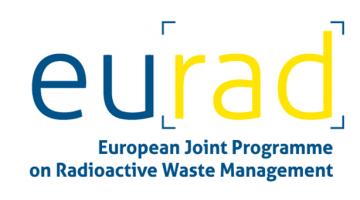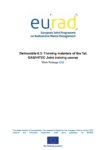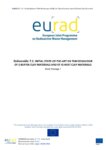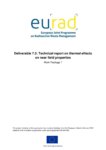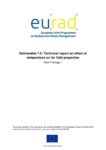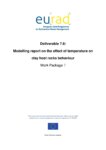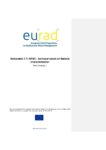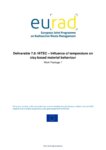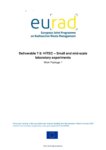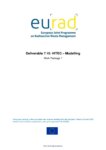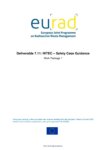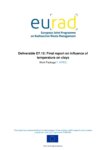HITEC: Influence of temperature on clay-based material behaviour (EURAD WP)
Project Dates: 1st June 2019 – 30 May 2024
Project Status: Finished
Project Website: https://www.ejp-eurad.eu/implementation/influence-temperature-clay-based-material-behaviour-hitec
HITEC was an RD&D Work Package (WP) within EURAD. It aimed to improve the THM (thermal, hydraulic and mechanical) description of clay-based materials at elevated temperatures.
Overview
The HITEC WP was selected for initiation in the first phase of EURAD, as the activity to “characterise bentonite/clay-based material evolution under specific conditions to provide data on hydro-mechanical, thermal and chemical behaviour” was identified as a high priority subject in Theme 3 (EBS properties, function and long-term performance), Phases 1-3, of the EURAD Roadmap. Furthermore, the Theme 4 (Geoscience to understand rock properties, radionuclide transport and long-term geological evolution) topic entitled “Improved understanding of the influence of temperature on radionuclide migration and representation of effects in geochemical models” was also rated as a medium priority activity.
For the disposal of HHGW it is important to understand the consequences of the heat produced on the properties (and their long-term performance) of the natural and engineered clay barriers. Most safety cases (for disposal concepts that involve clay) currently involve a temperature limit of 100°C. Being able to tolerate higher temperatures whilst still ensuring an appropriate safety standard would have significant advantages (e.g. shorter above-ground cooling times, more efficient packaging, fewer disposal containers, fewer transport operations, smaller facility footprints, etc.).
This WP integrated with the another EURAD RD&D WP which ran in parallel – Spent fuel characterisation and evolution until disposal (SFC) – which investigated the validity of the thermal limits currently applied, and also the accuracy of the assumed waste source term.
Objective
HITEC aimed to develop and document improved Thermo-Hydro-Mechanical (THM) understanding of clay based materials (host rock and buffer) exposed to elevated temperatures (>100°C) for extended durations. The WP’s raison d’être was to evaluate whether or not elevated temperature limits (of 100-150°C) are feasible and safe for a variety of geological disposal concepts for high heat generating wastes (HHGW).
HITEC focused on clay host rock formations (<120°C) and establish the possible extent of elevated temperature damage in the near or far field (e.g. from over pressurisation) and also the consequences of any such damage. The WP also looked at buffer bentonite and determine if temperature influences the buffer swelling pressure, hydraulic conductivity, erosion or transport properties (i.e. inhibits buffer safety functions).
Outcomes
The host rock clays were studied under saturated conditions under 120°C, while buffer bentonites were studied both in saturated and unsaturated conditions under 150°C.
In clay host rock, the overpressure generated by the thermal expansion of pore water and the solid rock skeleton may have deleterious consequences. In the far field, this could induce rock damage and reactivate fractures/faults. In the near field, this could induce fracture opening or propagation in this fractured zone, altering the permeability.
The major observations for the near field were as follows:
- Higher calcite content decreases self-sealing.
- Sample orientation shows no clear effect.
- Self-sealing is faster for tighter cracks.
- No significant temperature effect.
For the far field, short-term and long-term (creep) compression tests were performed. The initial heating before the short-term compression tests on the COx induced transitory pore water overpressure (due to thermal expansion) and then microcracks parallel to the bedding planes. Temperature has globally a
negative impact on the peak strength of the COx claystone until 100 °C. The decrease in the peak strength is the most significant for the parallel to bedding samples under uniaxial test conditions. These microcracks were also closed when the axial stress was increased during the compression tests performed perpendicular to bedding. According to the experimental results, temperature has a likely, but small under confining pressure, negative impact on the short-term resistance to failure of the COx claystone.
For bentonite buffer, proving that higher temperatures than presently accepted are suitable is very relevant even for current concepts. It increases safety margin and gives greater credibility to the design (e.g., if it is proven to work for 130°C then for 100°C it is likely to be safe). Also, this type of optimisation could be used to increase thermal limits on the bentonite buffer, reducing the footprint of the facility. So potentially significant cost savings and improved environmental sustainability.
No new processes were identified for bentonite, but swelling, swelling stress formation and water conductivity were studied in detail over 100° degrees C temperatures. Relationships delineated within Task 3.2 include: (i) the observation of swelling pressure and permeability as a function of temperature
for various dry densities, swelling strains, chemical states and conditions and (ii) water retention curves, as function of temperature. For the materials and conditions tested, an influence of elevated temperature on water retention capacity has been observed. Multiple test programmes, in both Ca- and Na-bentonite have also found evidence that, whilst changes to hydraulic permeability are not very significant, swelling
pressure can be substantially impacted by elevated temperatures under certain conditions. Further work to investigate and consider the mechanisms and consequences of this behaviour for repository design are recommended as a result.
The experiments and modelling at higher temperatures has required much development work, which was carried out successfully. Key results are new experimental observations and models for both materials studied in HITEC: clay host rock and buffer bentonite.

